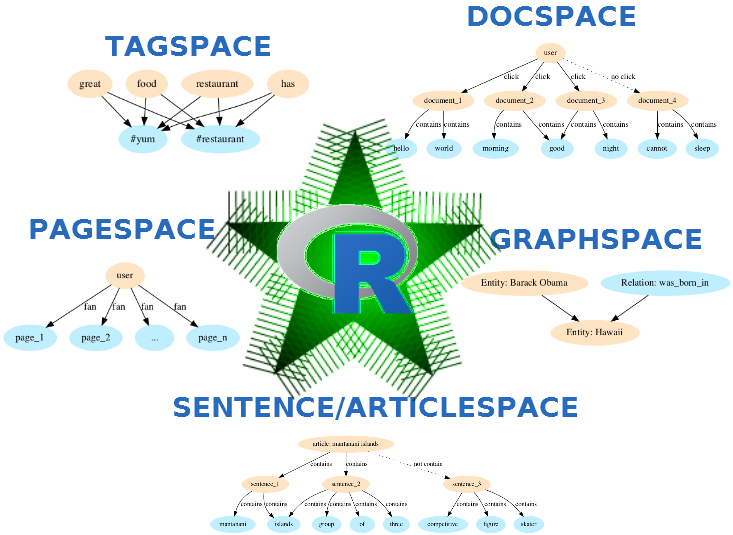
This repository contains an R package which wraps the StarSpace C++ library (https://github.com/facebookresearch/StarSpace), allowing the following:

install.packages("ruimtehol")devtools::install_github("bnosac/ruimtehol", build_vignettes = TRUE)Look to the vignette and the documentation of the functions
vignette("ground-control-to-ruimtehol", package = "ruimtehol")
help(package = "ruimtehol")This R package allows to Build Starspace models on your own text / Get embeddings of words/ngrams/sentences/documents/labels / Get predictions from a model (e.g. classification / ranking) / Get nearest neighbours similarity
The following functions are made available.
| Function | Functionality |
|---|---|
starspace |
Low-level interface to build a Starspace model |
starspace_load_model |
Load a pre-trained model or a tab-separated file |
starspace_save_model |
Save a Starspace model |
starspace_embedding |
Get embeddings of documents/words/ngrams/labels |
starspace_knn |
Find k-nearest neighbouring information for new text |
starspace_dictonary |
Get words/labels part of the model dictionary |
predict.textspace |
Get predictions along a Starspace model |
as.matrix |
Get words and label embeddings |
embedding_similarity |
Cosine/dot product similarity between embeddings - top-n most similar text |
embed_wordspace |
Build a Starspace model which calculates word/ngram embeddings |
embed_sentencespace |
Build a Starspace model which calculates sentence embeddings |
embed_articlespace |
Build a Starspace model for embedding articles - sentence-article similarities |
embed_tagspace |
Build a Starspace model for multi-label classification |
embed_docspace |
Build a Starspace model for content-based recommendation |
embed_pagespace |
Build a Starspace model for interest-based recommendation |
embed_entityrelationspace |
Build a Starspace model for entity relationship completion |
library(ruimtehol)
set.seed(123456789)
## Get some training data
download.file("https://s3.amazonaws.com/fair-data/starspace/wikipedia_train250k.tgz", "wikipedia_train250k.tgz")
x <- readLines("wikipedia_train250k.tgz", encoding = "UTF-8")
x <- x[-c(1:9)]
x <- x[sample(x = length(x), size = 10000)]
writeLines(text = x, sep = "\n", con = "wikipedia_train10k.txt")## Train
set.seed(123456789)
model <- starspace(file = "wikipedia_train10k.txt", fileFormat = "labelDoc", dim = 10, trainMode = 3)
model
Object of class textspace
dimension of the embedding: 10
training arguments:
loss: hinge
margin: 0.05
similarity: cosine
epoch: 5
adagrad: TRUE
lr: 0.01
termLr: 1e-09
norm: 1
maxNegSamples: 10
negSearchLimit: 50
p: 0.5
shareEmb: TRUE
ws: 5
dropoutLHS: 0
dropoutRHS: 0
initRandSd: 0.001embedding <- as.matrix(model)
embedding[c("school", "house"), ]
[,1] [,2] [,3] [,4] [,5] [,6] [,7] [,8] [,9] [,10]
school 0.008395348 0.002858619 0.004770191 -0.03791502 -0.016193179 0.008368539 -0.0221493 0.01587386 -0.002012054 0.029385706
house 0.005371093 -0.007831781 0.010563998 0.01040361 0.000616577 0.005770847 -0.0097075 0.01678141 -0.004738560 0.009139475
dictionary <- starspace_dictionary(model)## Save trained model as a binary file or as TSV so that you can inspect the embeddings e.g. with data.table::fread("wikipedia_embeddings.tsv")
starspace_save_model(model, file = "textspace.ruimtehol", method = "ruimtehol")
starspace_save_model(model, file = "wikipedia_embeddings.tsv", method = "tsv-data.table")
## Load a pre-trained model or pre-trained embeddings
model <- starspace_load_model("textspace.ruimtehol", method = "ruimtehol")
model <- starspace_load_model("wikipedia_embeddings.tsv", method = "tsv-data.table", trainMode = 3)
## Get the document embedding
starspace_embedding(model, "get the embedding of a full document")
[,1] [,2] [,3] [,4] [,5] [,6] [,7] [,8] [,9] [,10]
get the embedding of a full document 0.1489144 -0.09543591 0.1242385 -0.1080941 0.6971645 0.3131362 -0.3405705 0.3293449 0.231894 -0.281555The following functionalities do similar things. They see what is the closest word or sentence to a provided sentence.
## What is closest term from the dictionary
starspace_knn(model, "What does this bunch of text look like", k = 10)
## What is closest sentence to vector of sentences
predict(model, newdata = "what does this bunch of text look like",
basedoc = c("what does this bunch of text look like",
"word abracadabra was not part of the dictionary",
"give me back my mojo",
"cosine distance is what i show"))
## Get cosine distance between 2 sentence vectors
embedding_similarity(
starspace_embedding(model, "what does this bunch of text look like"),
starspace_embedding(model, "word abracadabra was not part of the dictionary"),
type = "cosine")Below Starspace is used for classification
library(ruimtehol)
data("dekamer", package = "ruimtehol")
dekamer$x <- strsplit(dekamer$question, "\\W")
dekamer$x <- sapply(dekamer$x, FUN = function(x) paste(setdiff(x, ""), collapse = " "))
dekamer$x <- tolower(dekamer$x)
dekamer$y <- strsplit(dekamer$question_theme, split = ",")
dekamer$y <- lapply(dekamer$y, FUN=function(x) gsub(" ", "-", x))
set.seed(123456789)
model <- embed_tagspace(x = dekamer$x, y = dekamer$y,
dim = 50,
lr = 0.01, epoch = 40, loss = "softmax", adagrad = TRUE,
similarity = "cosine", negSearchLimit = 50,
ngrams = 2, minCount = 2)
plot(model)
text <- c("de nmbs heeft het treinaanbod uitgebreid via onteigening ...",
"de migranten komen naar europa de asielcentra ...")
predict(model, text, k = 3)
predict(model, "koning filip", k = 10, type = "knn")
predict(model, "koning filip", k = 10, type = "embedding")Need support in text mining? Contact BNOSAC: http://www.bnosac.be